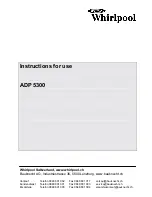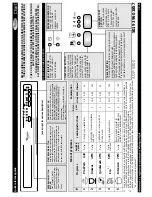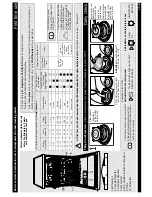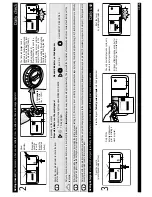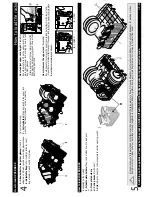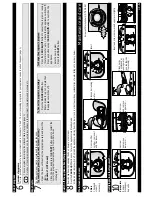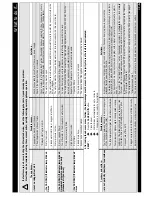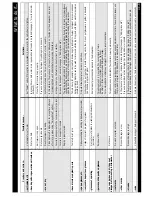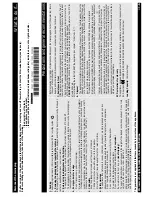
GB
-7-
What to do if
...
Crockery
and cu
tlery
...
P
o
ssible cau
ses
...
So
lu
tion
s...
...salt indicator lit
-
U
se tablets
for
soft water
.
-
Set “
T
ablet” op
tion
; if this optio
n
is not
availab
le, it is normal f
o
r
th
e sa
lt in
dicato
r
to
light
u
p
.
...have de
posit
s: re
gene
ration salt
residue
-
W
ater
too h
ard.
-
In
ar
eas
wi
th ve
ry
har
d
water
, mor
e
reg
e
ner
ation salt needs
to
be added (see page
2, “How
to set wat
e
r
ha
rd
nes
s”).
-
Salt reser
voir cap
open.
-
Close the salt reservoi
r cap proper
ly
.
-
N
ot enough rinse aid.
-
If you
use a
combined
action
detergent, try adding
more rins
e aid.
...are not dry
-
P
lastic containers dry badly
.
-
Synthet
ic
materials do not dry well;
if
wet at
end of
cycle, wipe dry
.
-
C
lean dishes left in dishwas
h
er for a long time after end
of
cycle
(e
.g. whe
n
using “Delayed start”
option).
-
In this
situat
ion, the pres
en
ce
of
drops
of w
ater on
dishes and
on the sides
of
the dishwasher
is normal.
Tr
y releasing the door 5 minutes before
removin
g the dishes.
-
Incorrect a
rrange
m
ent
of th
e c
o
nc
ave items in the
ra
ck.
-
A
rrange crockery so that
water does not
collect in cav
ities.
-
Incorrect dosage the rinse
aid.
-
Increase the dosage
of
rinse aid
(s
ee
page 3,
“A
dding rins
e aid”)
.
-R
ap
id
p
ro
gr
am
s
e
le
ct
e
d
.
-
T
he
rapid program is intended for
q
u
ickly
washing lightly
soil
ed
dishes.
If
used for
a
full load of medium
/heavy
so
iled
d
ishes, the di
shes may n
o
t dry
completely
. If so
, select a
st
andard
-lengt
h pr
ogr
am. For best resul
ts,
o
p
en the do
or after
th
e en
d of
th
e program and wa
it 15
min
u
tes befo
re un
loading the dishwasher
.
...ha
ve dis
coloure
d plastic parts
-
Tomato/Carrot
juice.
-
Tomato sauce,
for example, can lead
to
di
sc
olouring of plasti
c parts.
P
o
wd
er
detergent is recommended as
it al
lows sl
ightly
higher doses to be used for
im
pr
ov
ed whitening. P
ro
grams with
high
er wash
te
mperatures
should be used.
...opaque glasses, etc.
-
D
is
hes un
sui
ta
b
le
fo
r w
ashi
ng in
di
shwa
sher
s (
p
or
cel
ain
),
-
O
nly use dishwasher
-proof crockery
and dishes.
...remova
b
le depo
sits
on glasses
-
U
sage of incorrect programs
for glasses.
-
D
ishes should be put to
gether
,
to avoid touching each
other
.
Do
not put glas
sware
to
gether in baskets.
Use suitabl
e
program
for glass.
...glasses n
o
t sparkling
-
N
ot confor
m of
glasses to washi
n
g in dishwashers
(p
o
rc
e
la
in)
.
-
Some ki
nds of gl
ass cannot be
washed in the dishwasher
.
...permanent deposits on
glas
ses
-R
ai
n
b
o
w
e
ff
e
ct
.
-
T
his
phenomenon i
s i
rrevers
ible. W
e
recommend i
n
future:
-
C
hange
the control
of
system of do
sage
of
softener
.
-
B
e careful
– follow reco
mmended detergent dosage.
-
F
or combined
action tablets see
de
tergent producer
’s
recommendations.
...tea cups darken and dirt does not
disappear after wash
ing i
n
dishwashe
r
-
N
ot known.
-
T
his
ph
enomenon is inevitable. Theine
al
ters
colours permanently
.
...rus
t m
a
rks
-
P
re-
w
ash
pro
gram no
t used.
-
Salty or aci
d
ic
food residues can
cause
ru
st marks even
on stainless
st
eel cutlery
. T
o
avoid this,
always
use
the pre-w
as
h
program
if the di
shes are
to be wa
sh
ed later
.
...o
ther marks
-
R
ins
e
aid dosage too low
.
-
In
the
pres
en
ce of marks, incr
ease the rinse
aid d
o
sage
(see page
3, “
A
dding
rins
e
aid”).
-
If you
us
e a
combined action
dete
rgent, possibly add
more rins
e aid.
...s
treaks
-
R
ins
e
aid dosage too high.
-
In the pres
en
ce
of
streaks, reduce t
h
e
rins
e
ai
d
d
o
sa
ge
(
see
pa
ge
3
,
“A
dd
in
g r
in
se
ai
d”
).
-
If you
us
e a
combined action
dete
rgent which includes
rinse
aid,
do
not
add any
additional rinse
aid.
...s
uds
-
U
nsuitable dosage of
detergent/rinse aid.
-
O
nly use the amount of dete
rgent/rinse
ai
d required, since
excessive amounts can
lea
d
to excess suds
.

